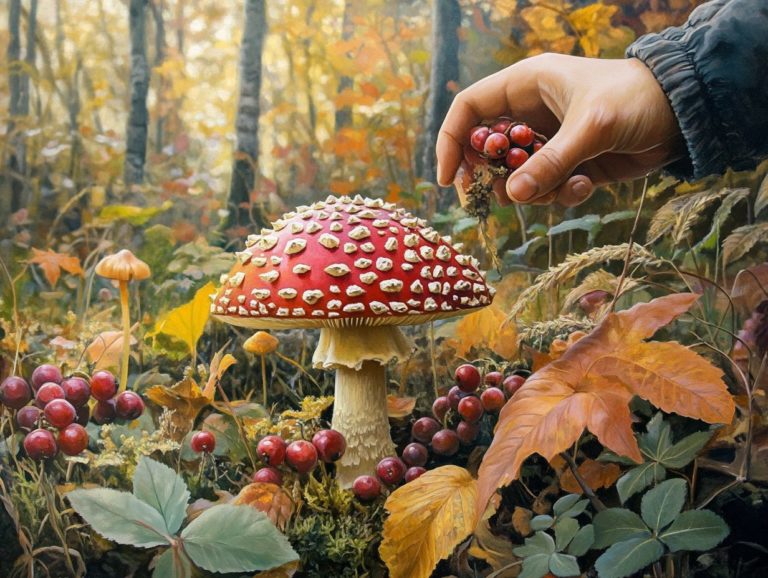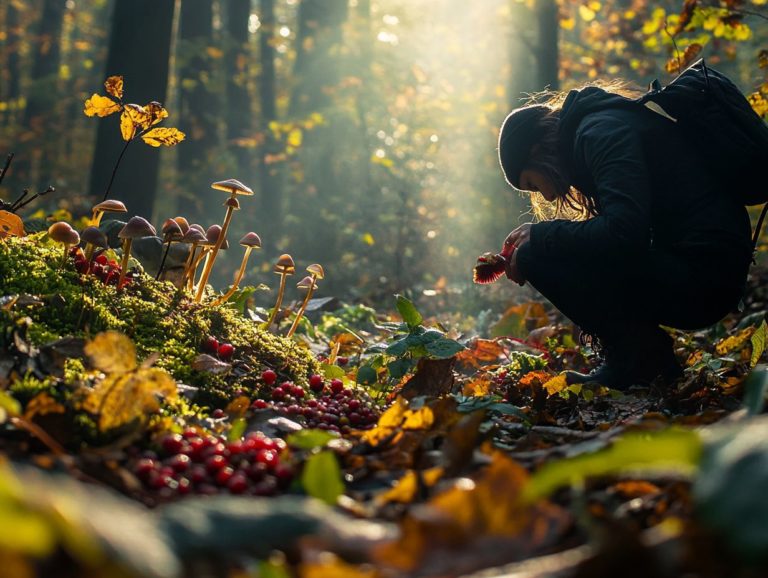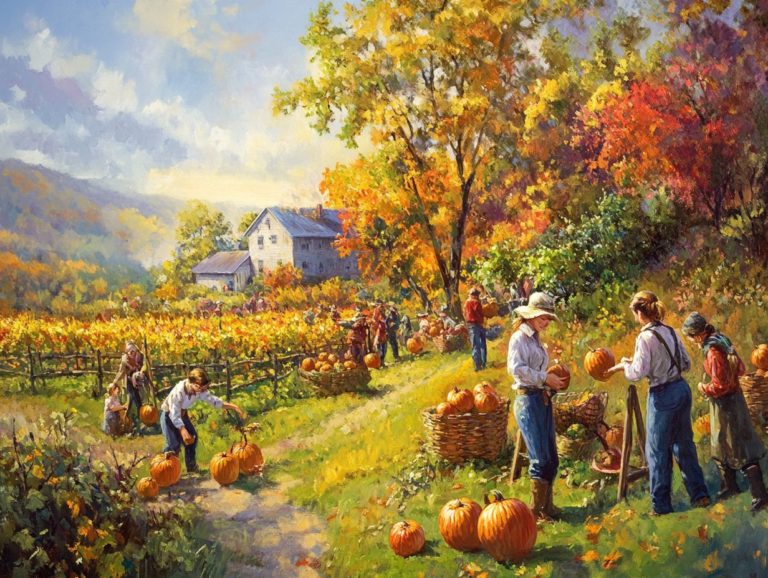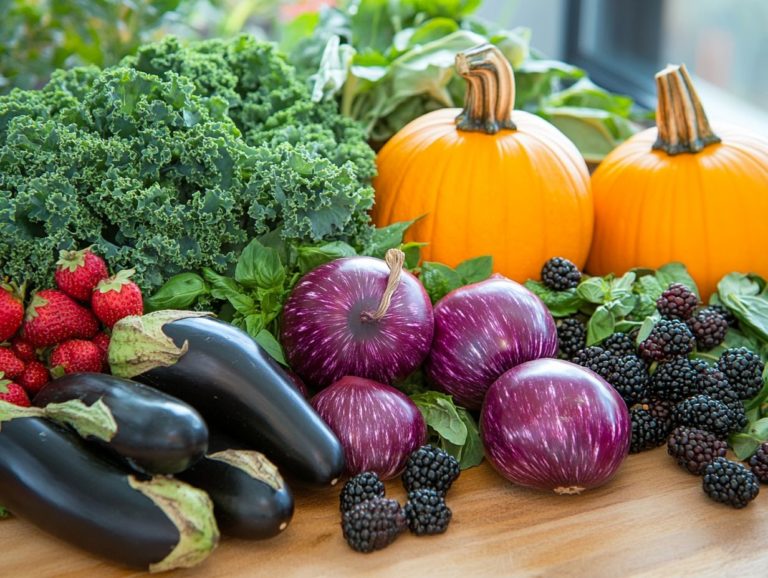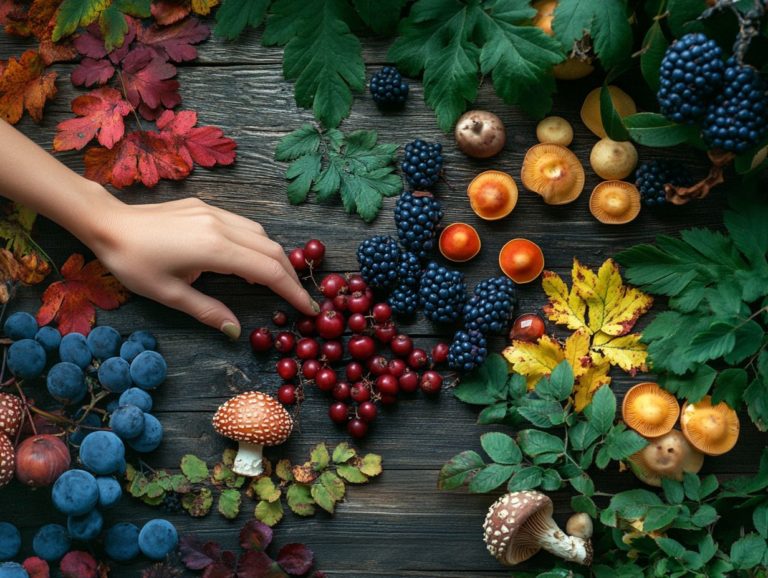What to Harvest: Seasonal Foraging Checklist
Foraging deepens your connection with nature and lets you enjoy seasonal delights!
Whether you re an experienced forager or just beginning to explore, understanding what to seek throughout the year can significantly enhance your experience. This guide presents comprehensive checklists for spring, summer, fall, and winter foraging, along with invaluable tips on identifying edible plants, the advantages of seasonal eating, and methods for safely incorporating foraged foods into your diet.
Uncover delightful recipes, ethical guidelines, and preservation techniques to truly maximize your foraging adventures!
Contents
- Key Takeaways:
- 1. Spring Foraging Checklist
- 2. Summer Foraging Checklist
- 3. Fall Foraging Checklist
- 4. Winter Foraging Checklist
- What Is Foraging and Why Is It Important?
- What Are the Benefits of Eating Seasonally?
- What Are the Risks of Foraging?
- What Are the Essential Tools for Foraging?
- How Can One Identify Edible Plants and Mushrooms?
- What Are Some Common Mistakes to Avoid When Foraging?
- How Can One Incorporate Foraged Foods into Their Diet?
- What Are Some Delicious Recipes Using Foraged Ingredients?
- How Can Foraging Help with Sustainable Living?
- What Are Some Tips for Ethical Foraging?
- How Can One Preserve Foraged Foods for Later Use?
- What Are Some Alternative Sources for Foraged Foods?
- Frequently Asked Questions
- What should I include on my seasonal foraging checklist?
- How do I know what is in season for foraging?
- Can I forage for food all year round?
- Should I be cautious of any potential dangers while foraging?
- Are there any rules or regulations I should be aware of when foraging?
- Why should I consider foraging for my food?
Key Takeaways:
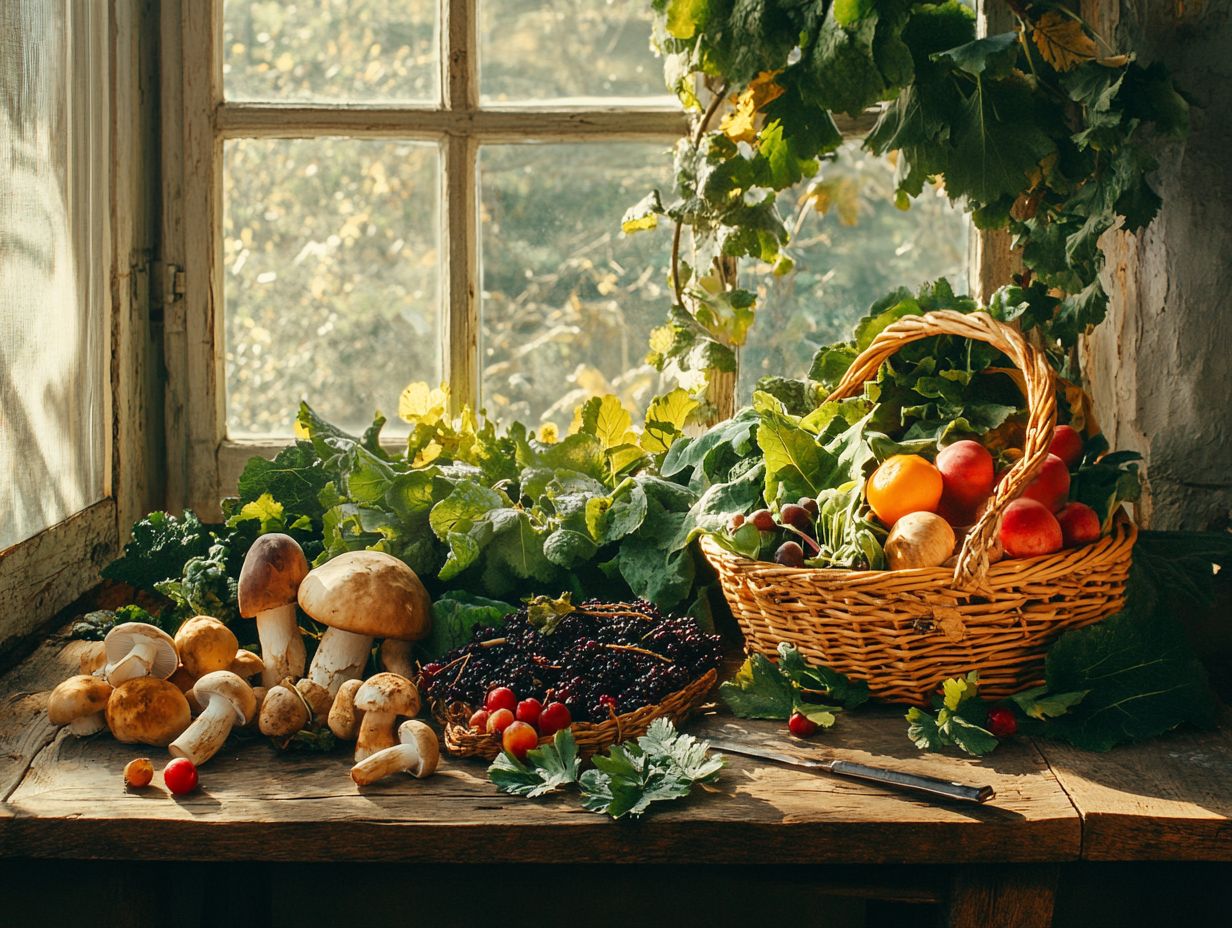
- 1. Consider the different seasons and their unique foraging opportunities before heading out to collect wild plants and mushrooms.
- 2. Eating Seasonally can provide numerous health benefits, such as increased nutrient density and variety in your diet, while also reducing environmental impact.
- 3. Proper identification of edible plants and mushrooms, as well as ethical and sustainable foraging practices, are crucial for a safe and enjoyable foraging experience.
1. Spring Foraging Checklist
Spring unveils a variety of wild edible plants just waiting for you to discover, such as Stinging Nettles, Dandelion Greens, and Wild Garlic. This season is thrilling for plant foraging enthusiasts like yourself, offering a unique chance to connect with nature and explore the edible treasures it holds. As winter fades away, seize the opportunity to gather these seasonal delights, enriching your pantry with nutritious options while honoring the environment through sustainable foraging practices.
Among these gems, Stinging Nettles stand out, brimming with vitamins A, C, and K truly a nutritional powerhouse! Dandelion Greens bring a deliciously bitter flavor and a wealth of beneficial antioxidants. And let s not forget Wild Garlic, whose distinct aroma can elevate any dish to new heights. When foraging, only take what you need and harvest from areas free of pesticides.
Proper identification is crucial, as some plants may have toxic look-alikes, or some plants that look similar can be poisonous. For those eager to learn, enrolling in workshops can provide invaluable insights, ensuring you can confidently enjoy and share the bounty of wild edibles while championing ethical harvesting practices.
2. Summer Foraging Checklist
During the summer months, you can delight in the bounty of nature with a wealth of wild edible plants like Blackberries, Elderberries, and Chickweed. These offerings provide an array of flavors and infuse your dishes with essential nutrients. This season offers exciting flavors that tantalize your taste buds while fostering a deeper connection to the natural world as you embrace the principles of sustainable and ethical foraging.
These vibrant plants elevate your dishes not just with their unique tastes but also with their impressive nutritional profiles, bursting with vitamins, minerals, and antioxidants that are beneficial for your health. For example, Blackberries are rich in vitamin C and fiber, making them a perfect addition to smoothies or desserts. Elderberries, renowned for their immune-boosting properties, can easily be transformed into syrups or jams. And then there s Chickweed, whose mild flavor can enhance salads or serve as a delightful garnish.
As you venture out foraging, always remember to practice responsible harvesting methods, such as:
- Taking only what you need
- Leaving plenty for wildlife
- Avoiding over-harvesting particularly vulnerable species
By embracing these ethical guidelines, you help ensure that these natural resources continue to thrive for future generations, allowing the timeless tradition of foraging to coexist harmoniously within the ecosystem.
Ready to discover what nature has to offer this spring? Get outside and explore!
3. Fall Foraging Checklist
Fall offers a great chance to gather wild edible plants like Burdock Root, Winter Mushrooms, Acorns, and Hazelnuts. Each of these delights brings unique flavors and health benefits.
This season invites you to connect deeply with nature while practicing responsible harvesting.
These natural treasures enhance your culinary repertoire and deliver essential nutrients think fiber from Burdock Root and healthy fats from Hazelnuts. Embrace sustainable foraging practices to ensure the ecosystem flourishes.
Properly identifying these plants is crucial to avoid harmful varieties. Engaging in foraging workshops can significantly boost your knowledge, equipping you to safely recognize and harvest these edibles. Plus, it fosters a sense of community and a shared appreciation for the great outdoors.
4. Winter Foraging Checklist
Winter foraging might seem tough, but it reveals exciting wild plants like Pine Needles and Rose Hips. They provide unique flavors and health benefits, turning winter into a treasure trove for food foragers.
Embracing the chill not only expands your culinary options but also deepens your appreciation for nature s resilience.
You can harvest the tender shoots of Dandelions for fresh salads. Additionally, the bark of certain trees can be stripped to create a delightful tea. Familiarize yourself with local ecosystems and adopt sustainable harvesting techniques to preserve these precious resources for future generations.
Correctly identifying plants is crucial, as some can be mistaken for toxic varieties. With the right knowledge and tools, you can fully embrace winter s offerings, enriching your meals and enhancing your health with seasonal wild ingredients.
What Is Foraging and Why Is It Important?
Foraging is the art of gathering wild edible plants. This practice can profoundly enrich your life by fostering a deep connection to nature.
It supports sustainability through the responsible harvesting of wild foods, resonating with the traditions of indigenous cultures.
This time-honored practice diversifies your diet with nutritious options and sharpens your awareness of the environment. It also enhances your plant identification skills, crucial for safe foraging.
By tapping into this rich history, you honor ancestral ways of life while gaining insights into local ecosystems and their seasonal offerings. Engaging in foraging allows you to appreciate the relationship between humans and the natural world, cultivating a sense of stewardship for the environment.
As communities rediscover these techniques, they elevate their culinary experiences and contribute to biodiversity conservation. This proves that sustainable practices can lead to a healthier planet.
Ultimately, foraging heightens your awareness of the impact of food choices, encouraging a harmonious coexistence with nature.
Join a local foraging workshop to boost your skills today! Share your favorite foraging stories with us!
What Are the Benefits of Eating Seasonally?
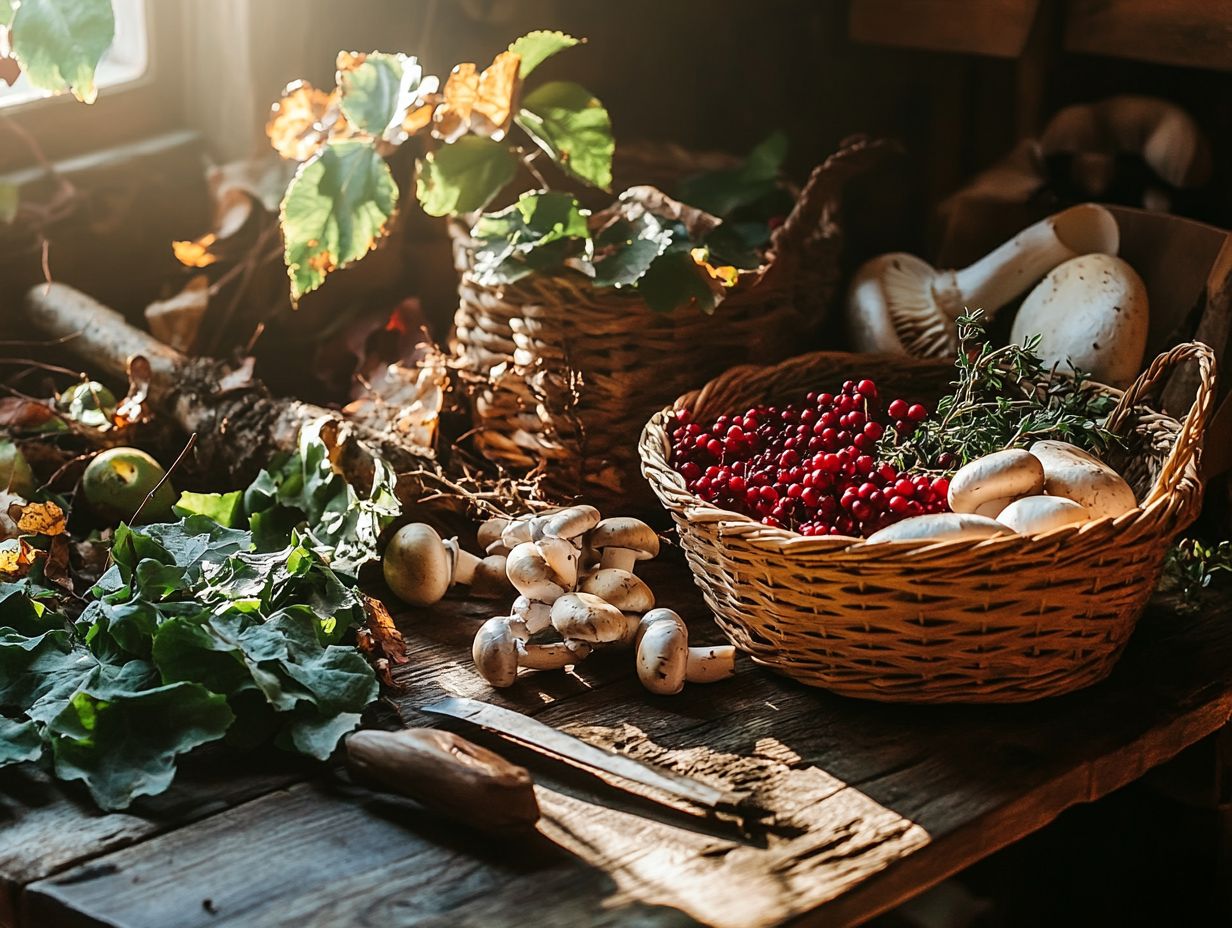
Eating seasonally has many nutritional benefits. Seasonal produce is often fresher and tastier, packed with essential vitamins.
This allows you to enjoy a healthy diet filled with vibrant, wild edible plants throughout the year. This practice not only elevates your cooking but also deepens your appreciation for environmental respect in consuming foods that align with natural cycles.
By opting for foods that are in season, you enhance your flavor experience. These fruits and vegetables are harvested at their peak maturity, allowing their natural sweetness and complexity to truly shine.
Embracing seasonal eating supports local economies and minimizes the carbon footprint associated with long-distance food transport.
Foraging for wild edible plants further enhances these benefits, giving you access to incredibly fresh and nutrient-dense options with minimal environmental impact.
This connection to nature helps foster healthier eating habits and enhances your overall well-being. The act of foraging gets you moving and promotes mindfulness in your dietary choices.
What Are the Risks of Foraging?
Foraging is an exciting adventure waiting for you to discover! It presents thrilling opportunities to find wild edible plants, but it also carries inherent risks, particularly the danger of misidentifying toxic species. This emphasizes the importance of honing your plant identification skills and practicing safe foraging techniques.
Understanding these risks is crucial for ethical foraging, allowing you to enjoy nature’s bounty without jeopardizing your health or the environment.
If you re inexperienced, you might unwittingly consume harmful vegetation, leading to serious health issues or even poisoning. To mitigate these dangers, dedicate time to education by using reliable guides and apps highlighting safe edibles and their lookalikes.
Joining local foraging groups can significantly enhance your knowledge through shared experiences and firsthand insights. This fosters a supportive community atmosphere. Always approach new plants with caution and consider consulting experts before consuming anything unfamiliar.
This blend of knowledge, resources, and community involvement creates a safer and more enriching foraging experience for you.
What Are the Essential Tools for Foraging?
Equipping yourself with essential tools for foraging is crucial for a successful and safe harvest. This ensures you can efficiently gather wild edible plants while enhancing your cooking.
With the right resources, such as field guides for plant identification and harvesting tips, you can embark on your foraging adventures with confidence and enjoyment. A seasonal guide can highlight the best times to forage various plants.
Key items include:
- Sturdy baskets for collection,
- Sharp knives for cleanly cutting plants,
- Gloves to protect against prickers or irritants.
A reliable field guide will be your best friend in distinguishing between similar-looking species, which is essential for your safety.
Joining foraging workshops grants you practical knowledge and allows you to learn from experienced foragers in real-life settings. This hands-on experience is invaluable, offering insights that books alone can’t provide and fostering a deeper appreciation for nature’s bounty.
Engaging in sustainable foraging practices during these workshops can help you make the most of your foraging experience.
How Can One Identify Edible Plants and Mushrooms?
Learning to identify plants is essential for you as an aspiring forager. It ensures that you can safely and successfully gather wild edible plants and mushrooms, letting you fully embrace nature s bounty without the lurking fear of consuming toxic varieties.
By leveraging foraging resources like field guides and workshops, you can significantly enhance your ability to accurately identify these edible treasures. Understanding indigenous cultures helps you appreciate the plants you find.
Engaging with local foraging communities creates a supportive environment for continuous learning. Here, shared experiences and valuable insights can exponentially improve your knowledge base. This community effort boosts your confidence and helps you respect nature, allowing you to make informed choices.
What Are Some Common Mistakes to Avoid When Foraging?
Foraging can be an incredibly rewarding activity, but many beginners often stumble into common pitfalls that can jeopardize their safety and lead to less-than-stellar food gathering. It’s crucial for you to understand what to avoid during your outdoor adventures. By recognizing issues like inadequate plant identification, misjudging plant habitats, and neglecting ethical foraging practices, you can enhance both your success and enjoyment in foraging. Remember to incorporate food foraging tips to maximize your success.
To sharpen your foraging skills, make thorough preparation a priority. Research the local flora and familiarize yourself with their ecosystems. Attending workshops or seeking mentorship from seasoned foragers can provide you with invaluable insights that elevate your expertise.
Creating a checklist of identifying features think leaf shape, flower color, and habitat preferences can streamline the identification process, making it far more efficient. Don’t overlook ethical considerations; foraging sustainably by ensuring enough plants remain for wildlife and future regeneration is essential. Always prioritize harvesting responsibly when you forage.
By embracing these practices, you can boost your confidence and ensure that your outdoor excursions are not only fruitful but also environmentally responsible.
How Can One Incorporate Foraged Foods into Their Diet?
Incorporating foraged foods into your diet opens up a world of cooking fun and flavor, allowing you to explore the unique tastes of wild edible plants while embracing seasonal offerings. By learning various cooking techniques and experimenting with these foraged ingredients, you can enhance your meals and forge a deeper connection with the food you consume.
Consider adding Stinging Nettles or Dandelion Greens to your dishes for added nutrition. One delightful way to begin is by adding wild greens, like dandelion or chickweed, to your salads for an earthy twist.
Foraged mushrooms can elevate your meals! They can infuse a simple risotto or pasta dish with depth and umami flavor. Imagine salsas or pestos crafted from foraged herbs vibrant condiments that beautifully complement grilled meats or roasted vegetables. Infusing oils or vinegars with wild herbs creates unique dressings, while wild berries can transform your desserts with their natural sweetness.
Integrating foraged foods adds variety to your cooking and promotes sustainability. Try incorporating foraged foods today to enjoy fresh flavors!
What Are Some Delicious Recipes Using Foraged Ingredients?
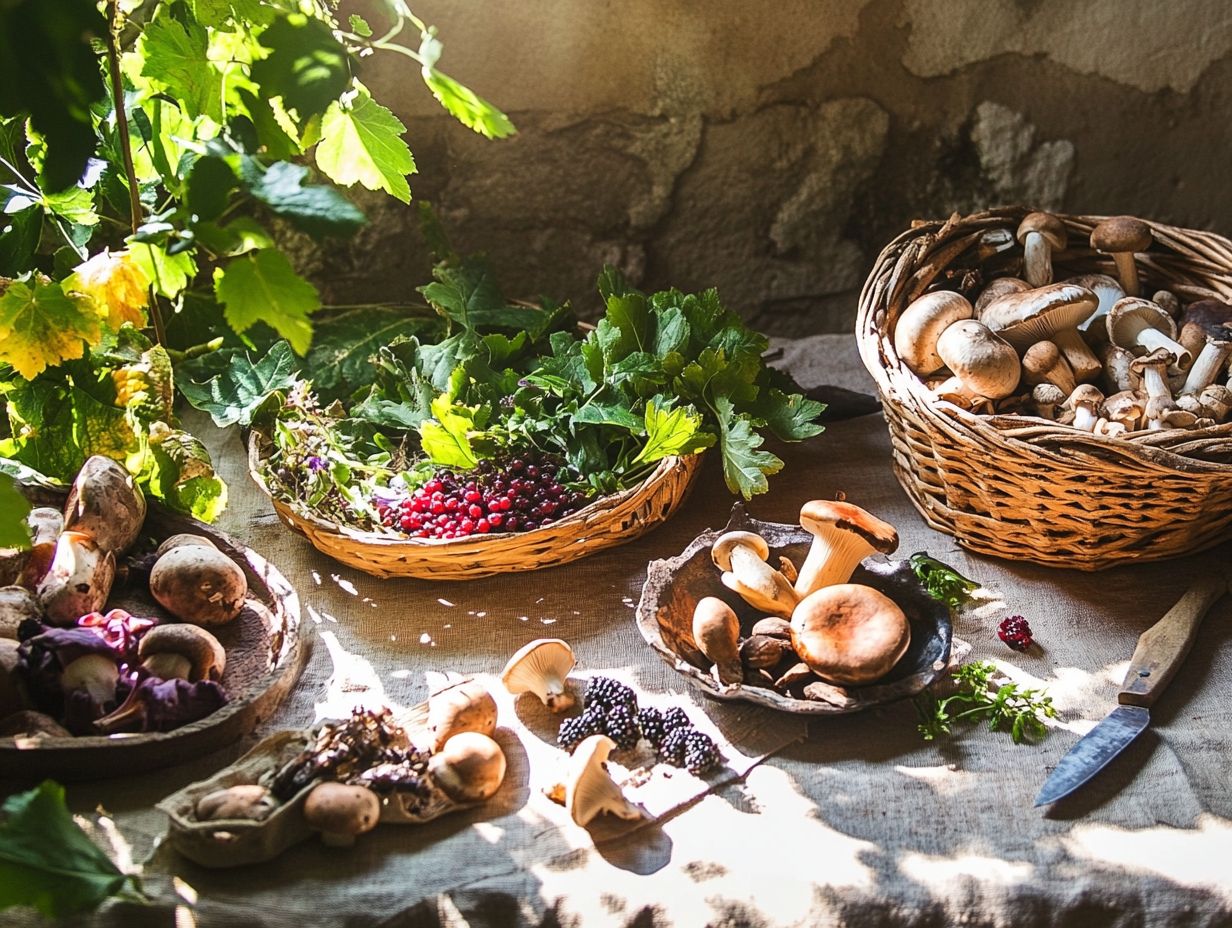
Crafting delicious recipes with foraged ingredients invites you to embrace the wild flavors of nature. It also promotes a sustainable lifestyle through the use of seasonal plants. This culinary journey showcases the diverse tastes found in the wild and elevates your dining experience with the unique characteristics of wild edible plants.
Imagine incorporating Dandelion Greens into a vibrant salad or featuring wild mushrooms in a rich risotto, highlighting the earthy, robust flavors they offer. Every recipe invites friends and family to explore local parks, forests, or even their own backyards, fostering a deeper connection with the environment. You might also consider foraging for Blackberries or Elderberries to enhance your desserts.
As you immerse yourself in foraging, the experience transforms from merely about food to a profound understanding and respect for the ecosystems that yield these treasures. Through simple yet innovative dishes, you can gather inspiration to craft your culinary masterpieces that celebrate the beauty of wild foods.
How Can Foraging Help with Sustainable Living?
Foraging plays an essential role in sustainable living, encouraging you to gather wild edible plants that thrive naturally in your environment. This practice reduces your reliance on commercially farmed foods and fosters a deeper respect for nature. As you learn to work in harmony with the land, you contribute to a more sustainable food system that values variety of plant and animal life and healthy environments. By practicing ethical foraging, you ensure that these plants remain available for future generations.
Foraging helps you appreciate the intricate relationships within ecosystems, prompting you to tread lightly and harvest responsibly. By foraging, you cut down on carbon footprints linked to transporting mass-produced items while nurturing your understanding of seasonal cycles and local flora.
Educational initiatives focused on foraging skills empower communities to learn sustainable harvesting methods. This ensures that future generations can benefit from nature s bounty while protecting the delicate balance of their surroundings. By prioritizing this harmonious relationship with nature, you become a steward of your environment, championing a shift toward more conscientious consumption.
What Are Some Tips for Ethical Foraging?
Engaging in ethical foraging is vital to ensuring that wild edible plants remain abundant and accessible for future generations. Start by understanding key principles like responsible harvesting and the ‘leave no trace’ philosophy. Prioritize plant identification and respectful gathering practices to maintain the delicate balance of ecosystems while savoring nature’s offerings.
Familiarize yourself with local regulations and guidelines, as different regions may impose specific restrictions on foraging practices. Only harvest what you need, being careful not to deplete any plant species. Avoid foraging in protected areas or on private lands without permission to respect and conserve these valuable ecosystems.
Remember to leave areas as you found them. Steer clear of trampling plants and disturbing wildlife habitats. This approach fosters a sustainable relationship with the environment, ensuring that future generations can enjoy the same bounties you do today.
Get out there and start foraging today to discover the wild flavors around you!
How Can One Preserve Foraged Foods for Later Use?
Preserving foraged foods is an invaluable skill that allows you to savor the rich flavors of wild edibles long after the foraging season has passed. This mastery enhances your cooking skills throughout the year and elevates your overall dining experience.
You can employ various methods such as drying, pickling, and freezing to maintain the quality and nutritional benefits of your foraged treasures. Exploring new ways to use wild plants can also offer exciting techniques for utilizing your finds.
Each technique presents unique advantages that dramatically influence your final dish. For instance, drying intensifies flavors and extends shelf life, making it particularly suitable for herbs and mushrooms. Pickling introduces a delightful tang, perfect for wild greens and vegetables, while freezing captures the freshest essence of fruits and certain greens.
To maximize flavor retention and stave off spoilage, it s crucial to properly cleanse your foraged plants, removing any dirt or pests. Using airtight containers for storage is essential. By understanding these methods, you not only preserve your bounty but also enhance your cooking skills, transforming the way you enjoy your foraged finds.
What Are Some Alternative Sources for Foraged Foods?
If you’re looking to elevate your foraging experience, consider exploring alternative sources for wild edible plants. Local markets, community gardens, and specialty stores dedicated to sustainable practices can provide you with unique options that delight any food forager.
Engaging in herbalism courses and foraging workshops equips you with invaluable knowledge and resources, perfect for diving deeper into nature s offerings.
These community-driven environments cultivate a greater appreciation for local biodiversity and promote the sharing of techniques and recipes among fellow enthusiasts. By visiting a nearby farmer’s market, you can uncover fresh foraged ingredients while interacting with vendors who are eager to share their own foraging tips.
Joining local foraging groups or participating in nature walks significantly enhances your practical skills, allowing you to connect with like-minded individuals who prioritize ethical and sustainable harvesting practices. This collaboration fosters stewardship toward the environment, reinforcing the importance of preserving natural habitats for future generations of foragers.
Watch this video to learn more about foraging techniques and preservation methods!
Frequently Asked Questions
Have questions about foraging? Here are some common inquiries to help you get started:
What should I include on my seasonal foraging checklist?
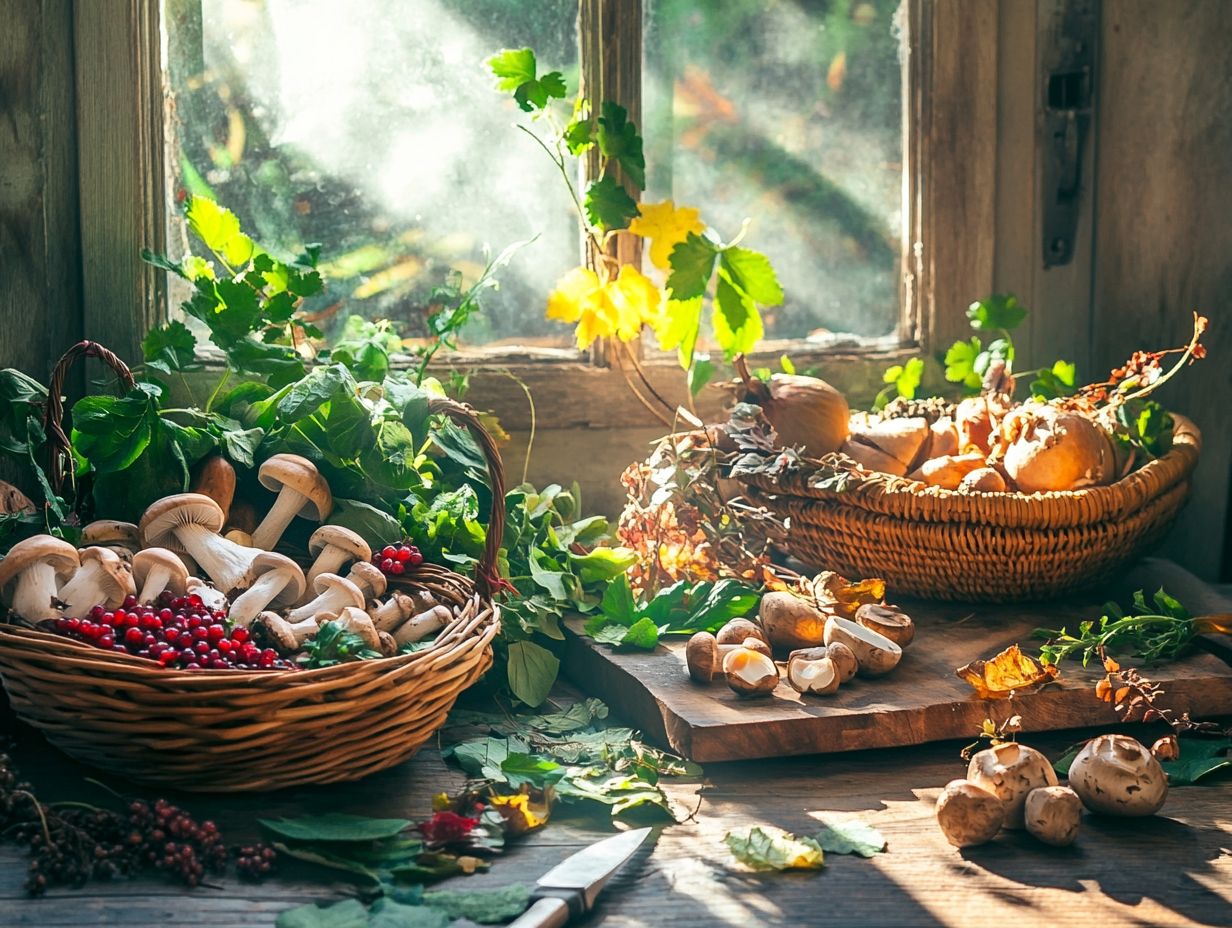
Your seasonal foraging checklist should include a variety of fruits, vegetables, and herbs that are in season and available to harvest. To learn more, check out what to know about seasonal foraging in your area.
How do I know what is in season for foraging?
You can research and consult a local foraging guide or find information online to determine what is in season for foraging in your specific area.
Can I forage for food all year round?
While some foods are available for foraging year-round, the best time to forage is during the specific season when certain plants are at their peak for harvesting.
Should I be cautious of any potential dangers while foraging?
Yes, it is important to be cautious and knowledgeable about the plants you are foraging for. Some may be poisonous or contain allergens, so always research and properly identify any plants before consuming.
Are there any rules or regulations I should be aware of when foraging?
Yes, always obtain permission from the landowner before foraging on private property. Additionally, follow any local foraging laws and regulations, such as limits on certain types of foraged foods.
Why should I consider foraging for my food?
Foraging can be a fun and sustainable way to connect with nature and source fresh, local ingredients for your meals. It can also save you money and reduce your carbon footprint by decreasing the need for store-bought produce that has been transported long distances.
Don’t miss out on the chance to experience the joy of foraging! Start exploring your local environment, join local groups, and immerse yourself in nature’s bounty.


